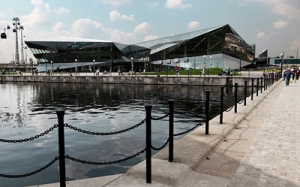Nov 15 2013
The Crystal, the global center for sustainable urban development built and operated by Siemens, is setting new standards in environmentally friendly and sustainable buildings.
This achievement is underscored by a further award that the Crystal recently received: LEED (Leadership in Energy and Environmental Design) Platinum. In July 2013, the building was already awarded the BREEAM (Building Research Establishment Environmental Assessment) "Outstanding" certificate, followed by LEED Platinum in late September. This makes the Crystal the world's only building to receive the top rating in both certification systems.
 The Crystal in London
The Crystal in London
"We invested a significant effort in making the Crystal one of the world's most energy efficient and sustainable buildings, by setting early on the highest standards in design, construction, technology and operation.", says Pedro Miranda, who heads the global Siemens Cities center of competence. "We are delighted that our innovation and technology solutions in the areas of energy efficiency and sustainability have been realized at the Crystal, achieving top certification levels LEED Platinum and BREEAM outstanding and setting an new industry benchmark."
The Crystal, whose shape and outer shell resemble a rock crystal, is a unique building. Occupying more than 6,300 square meters of space on the historic Royal Victoria Docks in the East of London, the building runs entirely on electricity and consumes no fossil resources such as oil or gas. Instead, it uses renewable energy sources, including wind power coming from the London Array off-shore wind farm. Two pipe systems measuring more than 17 kilometers in length and extending to a depth of up to 150 meters are located in the ground beneath the Crystal. Equipped with heat pumps, they cover all of the building's heating and cooling requirements. In addition, electricity for the Crystal is generated by a rooftop photovoltaic system. Covering an area of 1,580 square meters, this system generates approximately 20 percent of the total electricity demand which roughly covers the demand of the ground source heat pump for the heat and cold preparation. Another 19 square meters of thermal solar panels help produce hot water. Overall, the Crystal consumes 46 percent less energy and emits 65 percent less carbon dioxide than comparable office buildings.
The passive design that gives the building its extraordinary shape with many angles and sloping walls ensures natural lighting and shading in the interior. A natural ventilation system with 150 controllable façade openings reduces the cost of mechanical ventilation. The triple-glazed windows, which have a g value of 0.3, maximize the building's insulation. Rainwater as well as graywater and blackwater (waste water having different levels of contamination) are collected and purified right in the Crystal so that the building does not lose a single drop of water.
The advanced Desigo building automation system from Siemens controls and monitors all building operating parameters while the Siemens Advantage Operation Center (AOC) in Frankfurt, Germany, handles remote maintenance. The Crystal's users and visitors can see the latest energy and water consumption figures on Green Building monitors, motivating them to adopt environmentally friendly and sustainable practices in their own lives.
All of these innovative, active and passive design, building and operating parameters contributed to the building's LEED Platinum certification in the LEED For New Construction and Major Renovations (V2009) class. The Crystal earned the maximum number of points in the Water Efficiency (10/10), Innovation in Design (6/6) and Regional Priorities (4/4) categories and fell just short of the highest scores in the Sustainable Sites (24/26), Indoor Environmental Quality (10/15) and Energy and Atmosphere (28/35) categories. In addition, the building earned 4 out of 14 points in the Materials and Resources category thanks to its systematic waste management system; this category primarily rates waste avoidance through the reuse of existing building structures and did not apply to the Crystal because the lot was previously undeveloped. Overall, the Crystal earned 86 out of a possible 110 points.